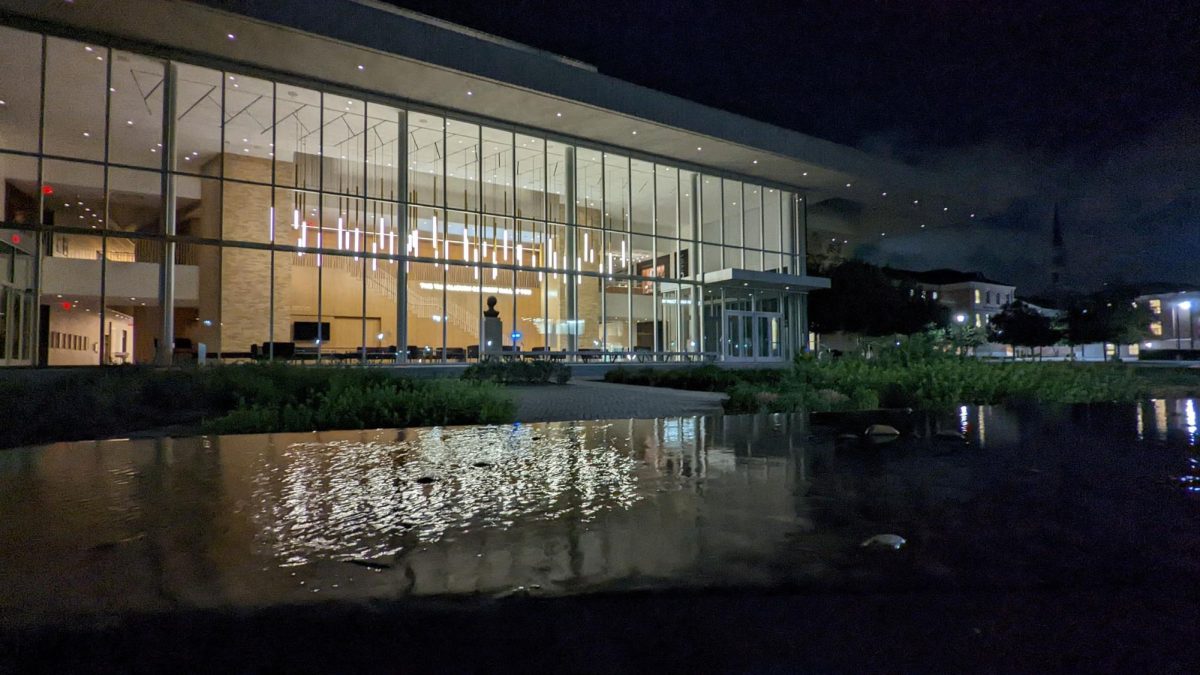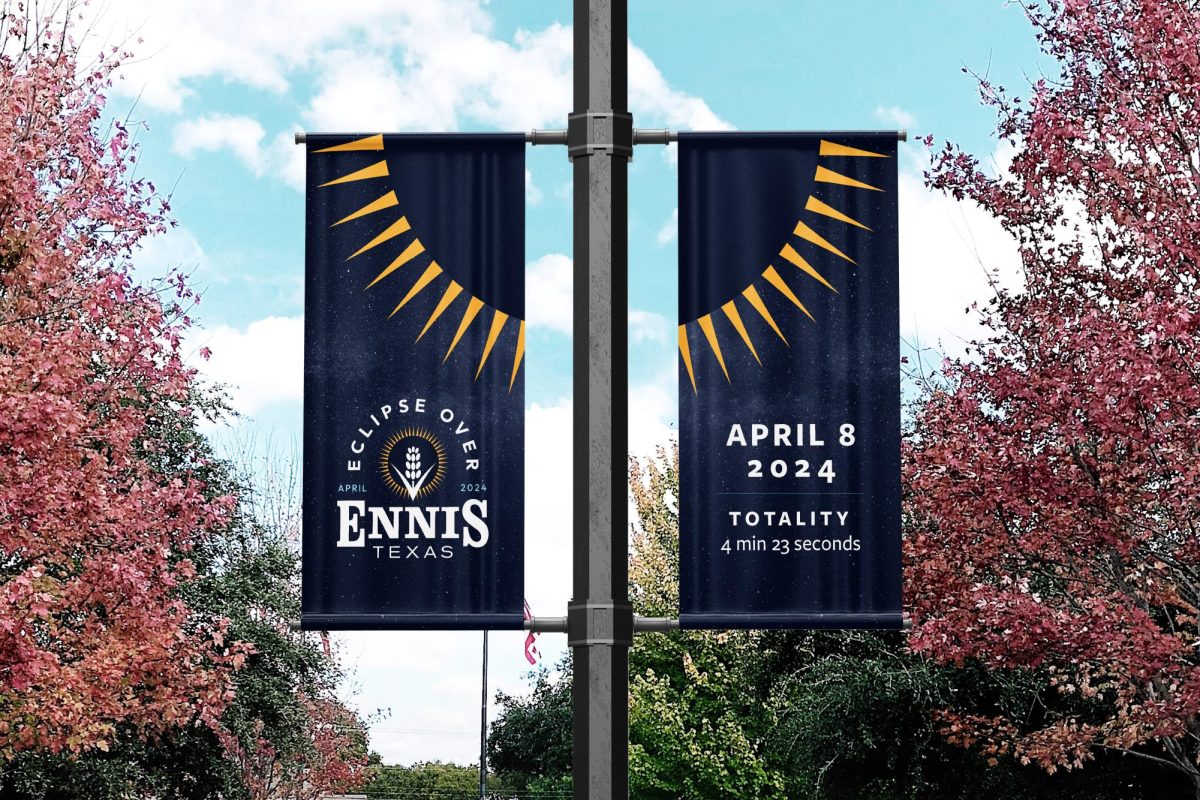The green field slopes gently down to a neatly kept garden.
Small vegetable planters line the garden’s fence, and leafy greens are beginning to emerge. Through the cast-iron gate, a dirt path winds through the canopy of trees and patches of native Texan bushes, flowers and cacti.
Fort Worth is in its fifth year of drought, with water restrictions limiting the resource’s use. The Alice Carlson Outdoor Learning Environment relies on an underground piping system, which allows the garden to thrive entirely without city water, said Sharon Chastain, the garden coordinator.
The garden demonstrates how to use rainwater harvesting techniques and native plant life to create a sustainable garden.
Pipelines gather rainwater from the gymnasium roof and collect condensation from the building’s air conditioning unit. This water travels downhill through underground pipes where it is stored in an aboveground tank. The water then feeds drip irrigation systems which water the garden, Chastain said.
Every inch of water from the roof creates about 1,000 gallons of water, said Jim Nelson, the designer of the rainwater harvesting system.
In 1996, Alice Carlson asked its students what they would like to do with the unused tennis courts in the school’s backyard. The students suggested several options, including a giant swimming pool.
After narrowing it down to more practical options, the school built the Outdoor Learning Environment in 1997, Chastain said.
The garden originally got a construction grant from the Rainwater Charitable Foundation that kick-started the garden’s construction. Since then, various grants and an annual donation from the Texas Master Gardeners Association have provided the money to maintain and improve the Outdoor Learning Environment.
Alice Carlson created the garden as a useful space the kids could utilize for learning, Chastain said. The Outdoor Learning Environment hosts science projects, plant observation, fossil digging and many other interactive class activities.
Through the Outdoor Learning Environment, students of Alice Carlson learn the importance of conserving water, Chastain said. She said they monitor the vegetable gardens and decide when it’s time to hand water.
The Outdoor Learning Environment consists of two levels. The first hosts multiple vegetable gardens and a living-roof shed covered by native grasses and cacti, Chastain said.
The lower lever is broken into sections, each representing a different section of the Texan ecosystem:
The Woodlands, where trees provide a shady canopy for benches.
The Rain Garden, where the more water-loving East Texas plants feed on the excess rainwater that gathers in a small pond.
The Prairie, a large patch of hardy Buffalo Grass.
The Desert, consisting of plants that don’t require any water outside of rainfall.
The Butterfly Garden, where a mixture of native and imported plants attract a myriad of butterflies to the Outdoor Learning Environment.
An arroyo runs diagonally across the garden, channeling rainwater towards gutters that distribute the water. Chastain said the arroyo runs like a river during rainfall, providing the Outdoor Learning Environment with water for weeks to come.
Near the entrance stands a small waterfall. A pump recirculates the water, allowing it to lose less water to evaporation than a stream would.
Seeing the conservation systems at work in the garden teaches students that water is not an endless commodity and must be protected, said Julie Tabor, a garden volunteer since 2012.
On a Monday morning earlier this month, a fourth grade class trekked across the lawn to visit volunteers working in the garden. The students asked volunteers when to plant potatoes, what type of fertilizer to use and what other vegetables they could plant in the spring.
Every fall and spring, students plant and observe vegetable seeds as a science project. In the spring, the children harvest the vegetables and donate them to the Tarrant Area Food Bank.
Students visit the garden twice a week on average and almost every day when planting a new crop.
“Some kids even ask to work in the garden during recess time,” Debbie Gerwick, a fourth grade teacher, said. “I think that says a lot about how much they enjoy their time in the garden.”
While using a miniature garden hoe to work fertilizer into the soil, fourth-grader Zoey Aguayo said visiting the garden is the highlight of her day.
“I love planting the vegetables,” Aguayo said. “It makes me happy to take care of them and see them grow.”
“It’s nice to get outside and feel the dirt in your hands,” Tabor said, “and to make a difference while doing that.”
Volunteers from the Sheriff’s Department currently provide the majority of labor for large projects in the garden. They meet every Monday and Thursday at 8:30 a.m.
Chastain said she hopes to recruit more help from local neighborhoods and organizations to improve the Outdoor Learning Environment.

TCU seniors have plenty of places to take senior photos on campus.
Published May 5, 2024
Published May 2, 2024
Published May 1, 2024
Published May 1, 2024
Published Apr 30, 2024
Local garden demonstrates water conservation
Published Mar 12, 2015
Before we break our arms patting ourselves on the backs because the plan to have a natural gas well on campus has apparently been avoided, maybe we should read between the lines.
It’s true that if Chesapeake Energy’s south side plan is approved by the city of Fort Worth, we will no longer have a gas well near the stadium, but the proposed well didn’t disappear. In fact, it mysteriously multiplied.
Opposition from the influential TCU community put politicians under pressure and brought lots of unwanted attention to the reality of urban drilling in the city.
QUICK LINKS
ABOUT TCU
FOLLOW US
TCU 360 is the official, student-produced product of the Department of Journalism in the Bob Schieffer College of Communication at Texas Christian University.
Our mission is to develop aspiring journalists who use accurate and ethical reporting to inform and serve people invested in TCU.
All Horned Frogs are welcome.
Copyright ©2024 TCU Student Media. All rights reserved.
Our mission is to develop aspiring journalists who use accurate and ethical reporting to inform and serve people invested in TCU.
All Horned Frogs are welcome.
Copyright ©2024 TCU Student Media. All rights reserved.




